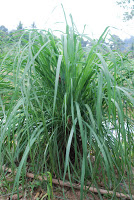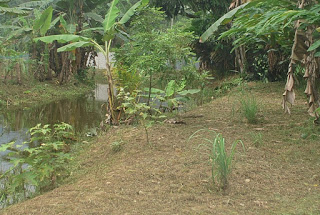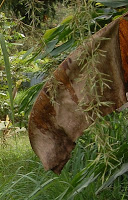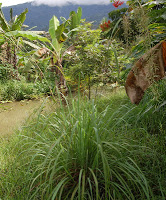This plant is considered a weed by some but I think of them as an “outdoors first aid kit”. I have these plants in several locations on the farm so it is nearby should I need them. It grows on the farm naturally and is known in Malay as Senduduk.
 |
| Senduduk Kampung Leaves |
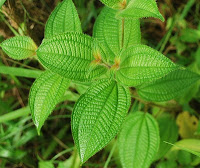 |
| Senduduk Hutan Leaves |
There are several varieties of this plant from the Melastomacaea family. There are two kinds that grow on the farm, Senduduk Kampung (Melastoma Malabathricum) and Senduduk Hutan (I am still searching for the botanical name). There are differences in them. To start with, the leaves look similar but there are distinct differences.
The senduduk hutan leaves have a more vivid green color with ridges along the edges as opposed to its”cousin”, which has a darker green and less refined details on the leaves and smoother edge.
It works very well on cuts (which happen quite often) and on insect bites including leech (pacat). The procedure for application to the affected area is always the same – takes 2-3 leaves, crush them using your fingers until it begins to produce a juice and rub the leaves on the affected area.
As the farm was previously a paddy field, whenever after several days of rain, on and off, the pacat sometimes seem to appear out of nowhere. So, when I am walking around the farm, going through some “weedy” areas, there are times when I get bitten by them. My quick remedy is to take a couple of leaves of the Senduduk Hutan and crush them with my finger until the juice appears and rub it on the bite area. In less than a minute, I find that the bleeding has stopped and where pacat bites are concerned, the itchiness that often follows after the bleeding has stopped does not occur.After a couple of days, I cannot find any traces of the bite anymore.
Working on the farm, getting cuts and nicks is a common occurence. The leaves once again, come to the rescue and stops the bleeding.
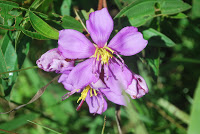 |
| Senduduk Kampung Flower |
 |
| Senduduk Hutan Flower |
On the farm, the senduduk kampung has purple flowers and senduduk hutan has white flowers. Both varieties grow naturally on the farm. I enjoy their beauty whenever I do my “walkabouts” on the farm, a beautiful color addition within all the greens. The flowers only open in the daytime, at times it is almost as if it follows the time when it receives direct sunlight.
Traditionally, the leaves are used as a treatment for cuts and burns and the young shoots are sometimes eaten as ulam. So while to some it may be considered a pest, careful growth control can eliminate this problem and yet you can have it available for its beneficial uses.
I have also discovered that the senduduk hutan leaves serves as a “agent” to remove the bitter taste from papaya shoots (pucuk betik) when they are boiled together. Remove the senduduk hutan leaves and water that was used for the boiling and proceed to cook the papaya shoots anyway you please such as adding them into sayur lemak or doing a stir-fry with achovies and sambal. Delicious!





